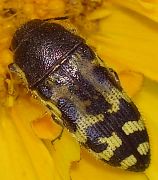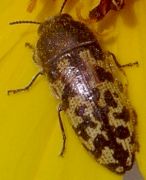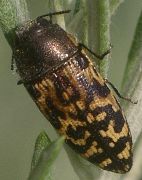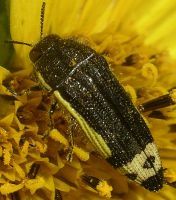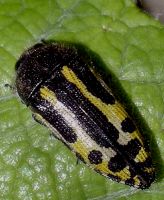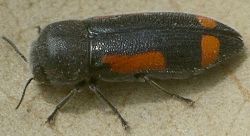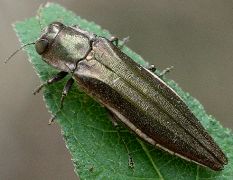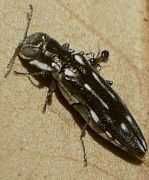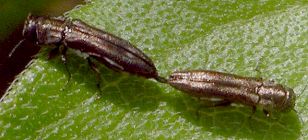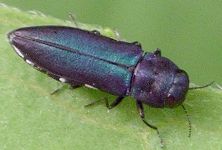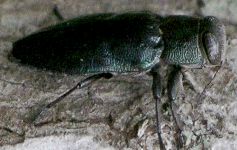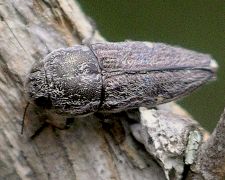
| Buprestidae ~ Metallic Wood-boring Beetles |
|
The cumbersome common name (too many syllables) of this family has led to the general practice of using the title "buprestids" just about as often as "metallic wood-boring beetles." The wood-boring habit refers to the larvae, which are known as flat-headed borers. Their front segments are broad and compressed, and the tunnels they create in wood are also very shallow. The diet of the larvae makes several species economically important pests, but other species of this family feed on leaves or stems instead of thicker wood. Because they burrow, the larvae are unlikely to be found without a lot of effort.
While the family is fairly large, these are not particularly common beetles, and they are quite wary, making them difficult to approach and photograph. The most likely genus to be seen is Acmaeodera because the adults are brightly marked and found at flowers. They fly frequently and often resemble bees at a glance. We have several common species and each one appears at a different time each year. The smallest Acmaeodera species shows up at flowers the earliest in the season: I've only seen them in early April. This might be either A. neglecta or A. neoneglecta and I've never been able to figure out which it is. Length is about 6 mm, and the colors are bronze with variable lighter tan markings.
The most common buprestid in this genus is Acmaeodera ornatoides. It flies from mid-April through May and is easily recognizable by its black color with tiny white flecks. In the right light, the black color of this beetle has a bluish metallic sheen. Most individuals are around 10 mm long. Upon close examination, it is noticeable that A. ornatoides has a sparse but soft-looking hairy pelt, the hairs of which stick straight out. Around mid-June through July, Acmaeodera mixta takes over the flower patrol. This species is just a little smaller than A. ornatoides and has shorter hair. The color of the head and pronotum is always dark bronze, but the elytra patterns vary considerably. The colors also vary, from tan to yellow as a base and dark bronze to black for the markings.
One of the most distinctive species in this genus is Acmaeodera flavomarginata. Besides the yellow sides noted in the species name, this mostly black beetle has a band towards the rear that can be either red or yellow. There is often a black spot in the very middle but sometimes it is quite small. The combination of a red band at one end and mostly black for the rest of the body is quite reminiscent of fireflies. I suspect that this simple color pattern, used by so many beetles, helps to protect this buprestid as well. The funny thing is that the "head" color of the firefly is reversed in this case so that it is at the opposite end. The yellow sides help make A. flavomarginata appear slimmer than it really is, which also fits with a firefly mimicry costume. This 10 mm long species shows up in autumn, around the end of September through mid-October.
I've only occasionally seen Acmaeodera scalaris but it has a very distinctive yellow and black pattern. About the same size as A. flavomarginata, it appears just after that species, around the end of October.
The Redbud Borer (Ptosima laeta) is similar in appearance to the previous genus, mostly because it has pretty colors. This insect is not particularly common, but does seem to show up each spring. As might be expected from the name, they feed on redbud trees (Cercis canadensis), and can usually be found around the trees when they are flowering in the spring. One genus with a lot of species is Agrilus. These are very slender buprestids and they range from a minute 4 mm to around 13 mm. They are only occasionally found on flowers, so the chance of seeing them is reduced. The largest member of this genus that I've seen appears to be rather common. Agrilus macer is about 12 mm long and has a dull metallic green topside. The edges of the body are light colored. There are distinctive ridges that run lengthwise down the center of the elytra. I've sometimes seen this beetle feeding on flowers but not frequently. The larvae of this species feed on Hackberry trees (Celtis sp.).
One attractive species about which I know very little and see only rarely is Agrilus limpiae. This 7 mm long buprestid is a dark bronze color with many elongate white dashes. I'm glad to say I've seen very few of the Soapberry Borer (Agrilus prionurus). This is a species introduced from Mexico and it can occur in heavy infestations that will kill Western Soapberry Trees (Sapindus saponaria). Soapberries are a small native tree that is sometimes also used for landscaping. The Soapberry Borer is about 7-8 mm long and is black with four white dots on the elytra.
Many Agrilus species are much smaller than the species already mentioned. The dark brown beetle shown here is only about 4-5 mm long. Although many beetles mate with the male climbing up behind the female, long and slender species tend to mate back to back, and that includes the tiny Agrilus species pair shown here. I suspect that the long slender shape makes it just too hard for the male to maintain balance. There are quite a number of other buprestids, but I only rarely happen to see them and even more rarely manage to photograph them before they fly away. Both the Anthaxia species and Chrysobothris analis shown here are medium-sized, at about 8 mm. The latter is not an optimal photo for identification, partly due to the skittishness of the subject. I highly recommend a dorsal view over a lateral one for most buprestids.
The Paratyndaris species is not at all common in our area. The larvae of this genus feed on the hardest wood and take several years to mature. The shape and size of the adult is reminiscent of Acmaeodera species but the body is heavily covered with hair that lies flat instead of sticking out, obscuring any underlying markings on the elytra.
A large and robust buprestid, Dicerca lurida is another species I've only rarely encountered. It is about 14 mm long and has very heavily sculpted elytra that terminate with little points. The color is a sort of vaguely metallic brown. |
![]()



